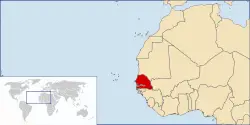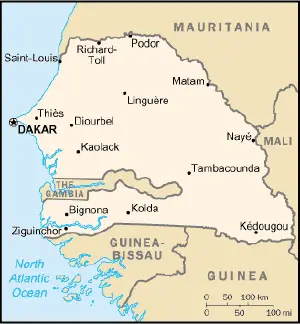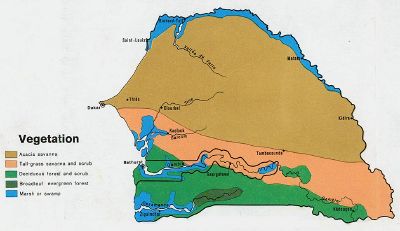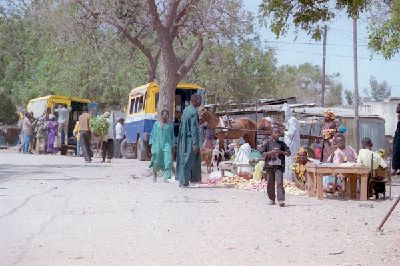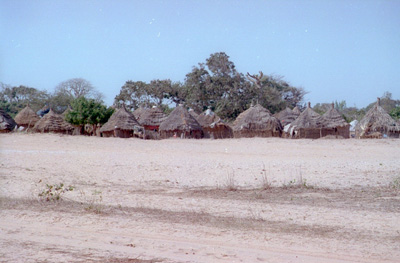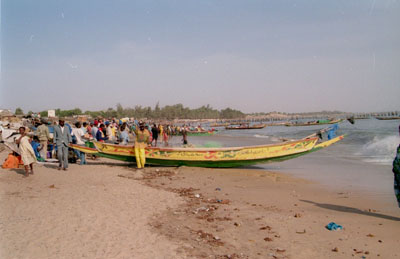Senegal
| République du Sénégal (French) Republic of Senegal |
||||||
|---|---|---|---|---|---|---|
|
||||||
| Motto:Â "Un Peuple, Un But, Une Foi"Â Â (French) "One People, One Goal, One Faith" |
||||||
| Anthem:Â Pincez Tous vos Koras, Frappez les Balafons Everyone strum your koras, strike the balafons |
||||||
| Capital (and largest city) | Dakar 14°40âČN 17°25âČW | |||||
| Official languages | French | |||||
| Recognized regional languages | Wolof, Pular, Jola, Mandinka, Serer, Soninke[1] | |||||
| Demonym | Senegalese | |||||
| Government | Unitary presidential republic | |||||
| Â -Â | President | Bassirou Diomaye Faye | ||||
| Â -Â | Prime Minister | Ousmane Sonko | ||||
| Independence | ||||||
| Â -Â | from France with French Sudan as the Mali Federation | June 20, 1960Â | ||||
| Â -Â | from Mali Federation | August 20, 1960Â | ||||
| Area | ||||||
|  - | Total | 196,723 kmÂČ (87th) 76,000 sq mi |
||||
|  - | Water (%) | 2.1 | ||||
| Population | ||||||
| Â -Â | 2023Â estimate | 18,384,660[1]Â (67th) | ||||
| GDPÂ (PPP) | 2023Â estimate | |||||
| Â -Â | Total | |||||
| Â -Â | Per capita | |||||
| GDP (nominal) | 2023Â estimate | |||||
| Â -Â | Total | |||||
| Â -Â | Per capita | |||||
| Gini (2021) | 36.2[3] | |||||
| Currency | CFA franc (XOF) |
|||||
| Time zone | UTC | |||||
| Internet TLD | .sn | |||||
| Calling code | +221 | |||||
Senegal, officially the Republic of Senegal, is a country south of the SĂ©nĂ©gal River in western Africa. The name "Senegal" comes from the Wolof Sunu Gaal, which means "Our Boat." It is one of only a handful of countries to have a near-enclave within its bordersâthe small nation of The Gambia, which penetrates more than 320 km into Senegal, from the Atlantic coast to the center of Senegal along the Gambia River, which bisects Senegal's territory. The area of Senegal south of The Gambia, known as the Casamance, has ample rainfall, in contrast to the dry lands to the north, and its distinctive people have a tradition of independence that led to a decades-long civil war.
Senegal, though poor, has a tradition of political stability and peaceful transfers of power. It successfully made the transition from a one-party state to a multiparty democracy in 2000.
The former French colony was a major shipping point for the slave trade from Gorée Island.
Geography
Senegal is a coastal West African nation that is slightly smaller than Great Britain or the U.S. state of South Dakota. It is bounded by the Atlantic Ocean to the west, Mauritania to the north, Mali to the east, and Guinea and Guinea-Bissau to the south, both borders running along the Casamance River, one of four rivers flowing from east to west, roughly parallel to each other.
The Cape Verde islands lie some 560Â kilometers (348Â mi) off the Senegalese coast, but Cap Vert is a peninsula near Senegal's capital Dakar, and the westernmost point in Africa.
Terrain
Though the terrain is generally low, rolling, plains rising to foothills in the southeast, the country also has tropical rainforest in the southwest and marsh or swampland along the coast. These lowlands are seasonally flooded but subject to periodic droughts. The lowest point in Senegal is the Atlantic Ocean, at sea level. The highest point is an unnamed feature near Nepen Diakha in the Fouta Djallon foothills at 1900 ft (581 m).
Wildlife populations are threatened by poaching; other problems are deforestation, overgrazing, soil erosion, desertification, and overfishing.
Climate
The local climate is tropical with well-defined dry and humid seasons that result from northeast winter winds and southwest summer winds. The rainy season (May to November) has strong southeast winds, and the dry season (December to April) is dominated by the hot, dry, harmattan wind. Dakar's annual rainfall of about 24 in (600 mm) occurs between June and October when maximum temperatures average 80.6°F (27°C); December to February minimum temperatures are about 62.6°F (17°C). Temperatures inland are higher than along the coast, where the Canary Current keeps temperatures more moderate, and rainfall increases substantially farther south, exceeding 60 in (1.5 m) annually in some areas.
History
Archaeological findings throughout the area indicate that Senegal was inhabited by 800 B.C.E., before the Sahara Desert began expanding southward and the region was wetter. Groups of megaliths up to 12 ft (3.5 m) high have been found near the mouth of the Senegal River.
Eastern Senegal was once part of the Empire of Ghana, which was based in Mali. In the ninth century, the Tukulor people founded the Tekrur empire, which converted to Islam in the eleventh century. Islam remains the dominant religion in Senegal. In the thirteenth and fourteenth centuries, the area came under the influence of the Mandingo empires to the east. The Jolof Empire of Senegal also was founded during this time and reached its height in the fifteenth century, which is when the Portuguese first encountered them.
European contacts
Various European powers - Portugal, the Netherlands, and England - competed for trade in the area from the fifteenth century onward, exchanging manufactured goods for hides, gum arabic (used for making paper, candy, and textiles), gold, and slaves, but the Europeans were confined to specified areas. When the Portuguese arrived in the mid-fifteenth century, they found many of the tribes already engaging in slavery, using those acquired in raids for agriculture and trading them to Arabs for horses.
In 1617, France established its first permanent settlement in Senegal, at what had become an important slave trade departure point: the infamous island of Gorée next to modern Dakar. A French fort was built at Saint Louis in 1659. In 1840 Senegal was declared a French possession, and in the 1850s the French began to expand their foothold, both militarily and economically, onto the mainland, at the expense of native kingdoms such as Waalo, Cayor, Baol, and Jolof. Senegal became a major producer of groundnuts (peanuts), starting in 1839 and continuing into the 1960s.
France granted some political rights to people in the major trading cities in Senegal, declaring them citizens and allowing them to elect a representative to the French parliament. The first African was elected in 1914. In 1946 Senegal was given two deputies in the French parliament. Under the constitution of 1946, the franchise was extended and a Territorial Assembly was established in Senegal. Universal suffrage was established in 1957. In 1958, Senegal accepted the new French constitution and became an autonomous republic within the French Community, part of Francophone Africa.
Independence
In January 1959, representatives of French Sudan (now Mali), Senegal, Dahomey (now Benin), and Upper Volta (now Burkina Faso) drafted a constitution for a Federation of Mali, but only the assemblies of French Sudan and Senegal ratified it and became members of the federation. The Mali Federation became fully independent in June 1960, as a result of the transfer of power agreement signed with France. Due to internal political difficulties, the federation broke up in August. Senegal and Sudan (Mali) proclaimed independence. LĂ©opold Senghor was elected Senegal's first president in September 1960.
Senghor and Prime Minister Mamadou Dia governed together under a parliamentary system. In December 1962, their political rivalry led to an attempted coup by Dia. Although this was put down without bloodshed, Dia was arrested and imprisoned, and Senegal adopted a new constitution that consolidated the president's power. His party, the Progressive Senegalese Union, was the single dominant party until Senghor authorized opposition parties in 1976. In 1980, Senghor decided to retire from politics, and he handed power over in 1981 to his handpicked successor, Abdou Diouf.
Senegal joined with The Gambia to form the nominal confederation of Senegambia on February 1, 1982. However, the union was dissolved in 1989. Despite peace talks, a southern separatist group in the Casamance region has clashed sporadically with government forces since 1982. Senegal has a long history of participating in international peacekeeping.
Abdou Diouf was president between 1981 and 2000. He encouraged broader political participation, reduced government involvement in the economy, and widened Senegal's diplomatic engagements, particularly with other developing nations. Domestic politics on occasion spilled over into street violence, border tensions, and a violent separatist movement in the southern region of the Casamance. Nevertheless, Senegal's commitment to democracy and human rights strengthened. Diouf served four terms as president. In the presidential election of 2000, opposition leader Abdoulaye Wade defeated Diouf in an election deemed free and fair by international observers.
Senegal experienced its second peaceful transition of power, and its first from one political party to another. Wade drafted a more democratic constitution that abolished the Senate and reorganized the National Assembly and judiciary branch. Women were granted equal property rights.
In 2004, Wade announced that he would sign a peace treaty with the separatist group in the Casamance region that was expected finally to end the 22-year-long rebellion, in which at least 3,500 people died, 50,000 refugees fled into The Gambia and Guinea-Bissau, and the region's once-booming tourist economy virtually collapsed.
In March 2012, the incumbent president Abdoulaye Wade lost the presidential election and Macky Sall was elected as the new President of Senegal. President Macky Sall was re-elected in 2019 elections. The presidential term was reduced from seven years to five.
Beginning in March 2021, Senegal was rocked by a series of mass protests in response to the arrest of Ousmane Sonko for alleged rape and mishandling of the COVID-19 pandemic. In June 2023, the response to the protests turned increasingly violent, with Amnesty International counting 23 fatalities, most of which were caused by bullets fired by police or armed police collaborators.[4]
In March 2024, Opposition candidate Bassirou Diomaye Faye won the Senegalâs presidential election over candidate of the ruling coalition, becoming the youngest president in Senegalâs history.[5]
Government
Senegal is a republic with a powerful presidency; the president is elected every five years, by universal adult suffrage.
Senegal is one of the few African states that has never experienced a coup dâetat. Power was transferred peacefully, if not altogether democratically, from the first president, Leopold Sedar Senghor, to Abdou Diouf in 1981, and thereafter in fully democratic elections.
Senegal has more than 80 political parties. The unicameral parliament consists of the National Assembly, which has 150 seats (a Senate was in place from 1999 to 2001 and 2007 to 2012).[1] An independent judiciary also exists in Senegal. The nation's highest courts that deal with business issues are the constitutional council and the court of justice, members of which are named by the president.
Senegal has a tradition of a flourishing independent media, largely free from official or informal control, though there were some reports of press restrictions prior to the February 2007 election. The countryâs generally tolerant culture, largely free from ethnic or religious tensions, has provided a resilient base for democratic politics.
The unicameral National Assembly has 120 members elected separately from the president. An independent judiciary also exists in Senegal. The nation's highest courts that deal with business issues are the constitutional council and the court of justice, members of which are named by the president.
Local administrators are appointed by, and responsible to, the president.
The national holiday is April 4, Independence Day.
Administrative divisions
Senegal is divided into 11 regions and subdivided into 34 departments, 94 arrondissements and multiple communes. The regions are:
|
|
|
|
Foreign relations
President Senghor advocated close relations with France and negotiation and compromise as the best means of resolving international differences. To a large extent, the two succeeding presidents have carried on Senghor's policies and philosophies.
Senegal has long supported functional integration among French-speaking West African states through the West African Economic and Monetary Union. Senegal has a high profile in many international organizations and was a member of the UN Security Council in 1988-1989. It was elected to the UN Commission on Human Rights in 1997. Friendly to the West, especially to France and the United States, Senegal also is a vigorous proponent of more assistance from developed countries to the Third World. Senegal will host the Organization of the Islamic Conference (OIC) Summit in March 2008.
In October 2005, relations with the People's Republic of China were renewed, and China has invested heavily in road building, sports stadiums, and education. In 2006 China announced a $22 million financial package involving debt forgiveness and funds for development.
There has been a twenty-year internal conflict in Senegalâs southernmost region of the Casamance. The ongoing peace process initiated in December 2004 began to deteriorate in late 2006. Dakar has yet to deliver a comprehensive plan for peace. The rebellion also involved neighboring Guinea-Bissau and The Gambia. With changes in the government of Guinea-Bissau, tensions between Senegal and its southern neighbor have lessened significantly; however, relations with The Gambia are still tense. There are recurrent tensions with Mauritania over water rights to the Senegal River and involving ethnic populations that move across porous borders.
The United States maintains friendly relations with Senegal and provides considerable economic and technical assistance. Senegal was President George W. Bushâs first stop in his July 2003 visit to Africa. Senegal took a strong position against terrorism in the wake of the September 11, 2001, terrorist attacks, and in October 2001 hosted a conference establishing the African Pact Against Terrorism.
Senegal continues to play a significant role in regional and international organizations.
Military
Senegal has well-trained and disciplined armed forces consisting of about 17,000 personnel in the army, air force, navy, and gendarmerie. Most of its training, equipment, and support come from France and the United States. Military noninterference in political affairs has contributed to Senegal's stability since independence.
In August 1981, the Senegalese military was invited into The Gambia by President Dawda Kairaba Jawara to put down a coup attempt. In August 1989, Senegalese-Gambian military cooperation, which began with the joint Senegalese-Gambian efforts during the 1981 coup attempt, ceased with the dissolution of the Senegambian Confederation. Senegal intervened in the Guinea-Bissau civil war in 1998 at the request of former President Vieira.
Senegal has participated in many international and regional peacekeeping missions, including the African Union mission in Darfur, Sudan, the UN mission in Liberia, and the UN mission in Cote dâIvoire. In 2000, Senegal sent a battalion to the Democratic Republic of Congo to participate in the UN peacekeeping mission, and agreed to deploy a U.S.-trained battalion to Sierra Leone to participate in another UN peacekeeping mission. A Senegalese contingent was deployed on a peacekeeping mission to the Central African Republic in 1997, and in 1994, Senegal sent a battalion-sized force to Rwanda to participate in the UN peacekeeping mission there. In 1991, it was the only sub-Saharan nation to send a contingent to participate in Operation Desert Storm in the Middle East.
Economy
In January 1994, Senegal undertook a bold and ambitious economic reform program with the support of the international donor community. This reform began with a 50 percent devaluation of Senegal's currency, the CFA franc, which was linked at a fixed rate to the former French franc and now to the euro. Government price controls and subsidies have been steadily dismantled. After seeing its economy contract by 2.1 percent in 1993, Senegal made an important turnaround, thanks to the reform program, with real growth in GDP averaging 5 percent annually during 1995-2001.
The main industries include food processing, mining, cement, artificial fertilizer, chemicals, textiles, refining imported petroleum, and tourism. Exports include fish, chemicals, groundnuts, cotton, and calcium phosphate. The principal foreign markets are Mali, India, France, Spain, Italy, and The Gambia. The port at Dakar makes it a major trade center.
Agricultural products include groundnuts, millet, corn, sorghum, rice, cotton, tomatoes, green vegetables; cattle, poultry, pigs; and fish.
As a member of the West African Economic and Monetary Union (WAEMU), Senegal is working toward greater regional integration with a unified external tariff. Senegal also realized full Internet connectivity in 1996, creating a miniboom in information technology-based services. Private activity now accounts for 82 percent of GDP. On the negative side, Senegal faces deep-seated urban problems of chronic unemployment, socioeconomic disparity, juvenile delinquency, and drug addiction.
More than three-fourths of the population is engaged in agriculture.
Demographics
Almost half of Senegal's population live in rural areas. Density in these areas varies from about 77/kmÂČ in the west-central region to 2/kmÂČ in the arid eastern section.
UNICEF in 2004 estimated that there are up to 100,000 child beggars in Senegal, constituting 1 percent of the population. It is unclear how many of them are talibes, those taken in by local Islamic teachers, known as marabouts, to study the Quran. The children, in return, gather money in tin cans they hold out to pedestrians and drivers at intersections and give their coins to the teachers.
Although most children complete primary school, much fewer go on to middle school and secondary school.
Ethnicity
Senegal has a wide variety of ethnic groups and, as in most West African countries, several languages are widely spoken. The Wolof are the largest single ethnic group; there are also Pular, Serer, Mandinka, Jola, Soninke, and others including Europeans and persons of Lebanese descent.[1]
About 50,000 Europeans (mostly French), as well as smaller numbers of Mauritanians and Lebanese, reside in Senegal, mainly in the cities. Also located primarily in urban settings are the minority Vietnamese communities.
From the time of earliest contact between Europeans and Africans along the coast of Senegal, particularly after the establishment of coastal trading posts, communities of mixed African and European (mostly French and Portuguese) origin have thrived. Cape Verdeans living in urban areas and in the Casamance region represent another recognized community of mixed African and European background.
French is the official language, used regularly by a minority of Senegalese educated in a system styled upon the colonial-era schools of French origin (Koranic schools are more popular, but Arabic is not widely spoken outside of this context of recitation). Most people also speak their own ethnic language while, especially in Dakar, Wolof is the lingua franca. Pulaar is spoken by the Peuls and Toucouleur. Portuguese Creole is a prominent minority language in Ziguinchor, regional capital of the Casamance, where some residents speak Kriol, primarily spoken in Guinea-Bissau. Cape Verdeans speak their native creole.
Religion
Islam is the predominant religion, practiced by approximately 96 percent of the country's population (most adhere to one of the four main Sufi brotherhoods); the Christian community, at 4 percent of the population, includes Roman Catholics and diverse Protestant denominations. There is also a tiny minority who practice animism, particularly in the southeastern region of the country.
Islam
Islamic communities are generally organized around one of several Islamic Sufi orders or brotherhoods, headed by a khalif (xaliifa in Wolof, from Arabic khalÄ«fa), who is usually a direct descendant of the groupâs founder. The two largest and most prominent Sufi orders in Senegal are the Tijaniyya, whose largest sub-groups are based in the cities of Tivaouane and Kaolack, and the MurÄ«diyya (Murid), based in the city of Touba. The Halpulaar, a widespread ethnic group found along the Sahel from Chad to Senegal, representing 20 percent of the Senegalese population, were the first to be converted to Islam. The Halpulaar, composed of various Fula people groups, named Peuls and Toucouleurs in Senegal. Many of the Toucouleurs, or sedentary Halpulaar of the Senegal River Valley in the north, converted to Islam around a millennium ago and later contributed to Islam's propagation throughout Senegal. Most communities south of the Senegal River Valley, however, were not thoroughly Islamized until the nineteenth and early twentieth centuries. During the mid-nineteenth century, Islam became a banner of resistance against the traditional aristocracies and French colonialism, and TijÄnÄ« leaders Al-Hajj Umar Tall and MĂ bba Jaxu Ba established short-lived but influential Islamic states but were both killed in battle and their empires than annexed by the French.
The spread of formal Quranic school (called daara in Wolof) during the colonial period increased largely through the effort of the Tijaniyya. In Murid communities, which place more emphasis on the work ethic than on literary Quranic studies, the term daara often applies to work groups devoted to working for a religious leader. Other Islamic groups include the much older QÄdiriyya order and the Senegalese Laayeen order, which is prominent among the coastal Lebu. Today, most Senegalese children study at daaras for several years, memorizing as much of the Qur'an as they can. Some of them continue their religious studies at informal Arabic schools (majlis) or at the growing number of private Arabic schools and publicly funded Franco-Arabic schools.
Christianity
Small Roman Catholic communities are mainly found in coastal Serer, Jola, Mankanya and Balant populations, and in eastern Senegal among the Bassari and Coniagui. In Dakar, Catholic and Protestant rites are also practiced by a portion of the Lebanese, Capeverdian, European, and American immigrant population, and among certain Africans of other countries. Although Islam is Senegal's majority religion, Senegal's first president, LĂ©opold SĂ©dar Senghor, was a Catholic Serer.
Other religions
Animism is the other main religion practiced. There are also small numbers of adherents of Judaism and Buddhism. Judaism is followed by members of several ethnic groups, while Buddhism is followed by a number of Vietnamese.
Culture
Senegalese society is sharply divided between the urban culture and rural farmers, perpetuating divisions that have their roots in the French colonial period. Africans born in the four major French areasâDakar, Goree, Rufisque, and Saint-Louisâwere granted French citizenship, could attend school in France, and had access to employment. Today, even in urban areas, housing varies from upper-class homes to crudely constructed huts in the shantytowns made up of recent migrants. In rural villages, family compounds surround a village center. Each compound consists of mud huts enclosed by a fence of dried palm fronds or reeds. Married sons and their wives live in the family compound.
Traditionally, the Senegalese are polygynous, and nearly two-thirds (62 percent) of women live in a polygamous marriage, the third highest rate in the world. While in rural areas their roles are still largely confined to domestic duties, in the cities they are entering the labor force in such roles as secretaries and unskilled labor. More boys than girls are educated, but the gap is slowly closing.
Arts and crafts
The Wolof, who are the dominant ethnic group in Senegal, are known for their skilled craftsmanship, including pottery, woodcarving, basketry, and making designs on cloth. The Fulani are best known for their leather work with geometric designs. Serer and Malinke craftsmen make high-quality jewelry.
Music has both social and religious functions in traditional villages, especially the use of percussion instruments. Youssou N'Dour and Baaba Maal are two popular singers who have an international reputation. Drama in Senegal is an outgrowth of ritual dances that combined drama, costumes, and song. In the 1960s, the government created a national theatrical company that includes singers and musicians, dancers, and actors. Ritual dances that accompanied religious ceremonies have evolved into less structured events but remain an important leisure activity. Usually they involve groups of dancers moving in lines to instrumental music and chants. The national dance company has toured abroad.
In the 1960s, Senegalese painters began to develop their own style, called Ecole de Dakar. Paintings on glass that depict everyday life are a local specialty.
Senegal plays a key role in West Africa's culture, despite its small size and population. From Senghor to Mariame BA, Senegal has produced some of the best African poets, writers, and film-makers. During the nineteenth century, there was a movement to integrate Senegal into the cultural Muslim world. Later, LĂ©opold Sedar Senghor and Cheikh Anta Diop contributed to the evolution of Pan-Africanism and the restoration of the value of Negro culture. The first World Festival of Negro Arts, which was organized in Dakar in 1966, was one of the greatest events in Senegal's cultural life.
Sports
The traditional Senegalese sport is a form of wrestling called laambi, but the most popular sport is soccer. Other sports are basketball, cricket, and track and field.
Cuisine
The typical Senegalese meal is rice with fish. In rural areas, it may simply consist of a millet mash with a spicy sauce. Because most of the rice must be imported, at great cost, the government is trying to get people to switch to maize, which has more protein and can be grown more widely.
Issues
Despite its political stability, most Senegalese live in poverty, eating simple meals and suffering from poor health due to malnutrition and poor sanitation. The degree of risk is considered very high of contracting food or waterborne diseases such as bacterial and protozoal diarrhea, hepatitis A, and typhoid fever; vectorborne diseases such as dengue fever, malaria, yellow fever, Crimean-Congo hemorrhagic fever, and Rift Valley fever are high risks in some locations. Schistosomiasis, a disease caused by a parasitic worm, is widespread. River blindness is also a risk, affecting 20 percent of the population in some areas. Health care is rudimentary outside the main cities, with 70 percent of the doctors located in Dakar.
The economy heavily relies on the export of groundnuts (peanuts in the United States), established as a cash crop by the French governor in the nineteenth century. That leaves the economy susceptible to climate changes and market fluctuations. Senegal produces one million metric tons of groundnuts a year. Fishing is another important revenue-earner, but overfishing by factory trawlers off the coast, particularly from the European Union, has severely hurt fish stocks. Increasingly, Senegalese are employing aquaculture, and farmers are turning to fish production.
Tourism has become the second most important earner of foreign exchange after fish, and the government is working to increase receipts from this source.
Unemployment is the biggest challenge, especially among restless young people. Others include the continuing Casamance conflict, as well as alleged corruption.
Notes
- â 1.0 1.1 1.2 CIA, Senegal The World Factbook. Retrieved April 4, 2024.
- â 2.0 2.1 2.2 2.3 World Economic Outlook Database, October 2023 Edition. (Senegal) International Monetary Fund. Retrieved April 4, 2024.
- â Gini Index: Senegal The World Bank. Retrieved April 4, 2024.
- â Elian Peltier, âThe State Killed My Brotherâ: Senegal in Uproar After Deadly Protests The New York Times (June 12, 2023). Retrieved April 4, 2024.
- â Jessica Donati and Babacar Dione, Senegal swears in Africaâs youngest elected leader as president in a dramatic prison-to-palace rise Associated Press (April 2, 2024). Retrieved April 4, 2024.
ReferencesISBN links support NWE through referral fees
- Berg, Elizabeth. Senegal. Cultures of the world. New York: Marshall Cavendish, 1999. ISBN 076140872X
- Cutter, Charles Hickman. Africa, 2006. World today series. Harpers Ferry, WV: Stryker-Post Publications, 2006. ISBN 1887985727
- Iliffe, John. Africans: the history of a continent. African studies series, 85. Cambridge: Cambridge University Press, 1995. ISBN 978-0521482356
External links
All links retrieved April 4, 2024.
- Senegal Country Profile BBC.
- Senegal Encyclopaedia Britannica.
- Senegal The World Factbook
- Senegal US Department of State.
- Senegal: Country Facts United Nations.
- The World Bank in Senegal The World Bank.
Credits
New World Encyclopedia writers and editors rewrote and completed the Wikipedia article in accordance with New World Encyclopedia standards. This article abides by terms of the Creative Commons CC-by-sa 3.0 License (CC-by-sa), which may be used and disseminated with proper attribution. Credit is due under the terms of this license that can reference both the New World Encyclopedia contributors and the selfless volunteer contributors of the Wikimedia Foundation. To cite this article click here for a list of acceptable citing formats.The history of earlier contributions by wikipedians is accessible to researchers here:
The history of this article since it was imported to New World Encyclopedia:
Note: Some restrictions may apply to use of individual images which are separately licensed.


